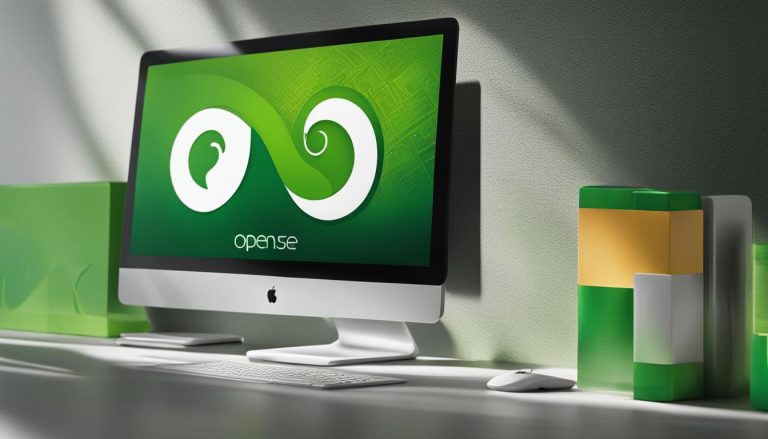Unraveling the Mystery: What is CentOS Stream?
CentOS Stream is an open-source platform that is revolutionizing the future of enterprise Linux. It offers a unique solution that combines the stability of CentOS with the fast-paced development of Fedora. With CentOS Stream, users can access and contribute to the latest software updates and features, making it a dynamic and cutting-edge distribution.
CentOS Stream is designed as a rolling-release distribution, providing continuous updates and improvements. It fills the gap between the renowned stability of CentOS and the need for developers and enthusiasts to stay on the leading edge of technology.
Whether you’re a seasoned developer looking to test new features or an organization seeking a flexible Linux platform, CentOS Stream has you covered. It offers a powerful and agile solution that enables you to leverage the latest advancements in enterprise Linux.
Key Takeaways:
- CentOS Stream bridges the gap between stability and rapid development in enterprise Linux.
- It is a rolling-release distribution that allows for testing, development, and quick access to the latest updates.
- CentOS Stream provides a flexible and powerful solution for developers and organizations alike.
- Users can contribute to the development process and shape the future of CentOS Stream.
- The project continues to evolve and improve, ensuring a promising future for CentOS Stream.
Understanding the Differences: CentOS Stream vs CentOS
When it comes to Linux distributions, CentOS Stream and CentOS may seem similar at first glance. However, they have distinct differences that set them apart. CentOS is known for its stability and long-term support, making it a reliable choice for enterprise-grade systems. On the other hand, CentOS Stream offers a rolling-release distribution that focuses on providing the latest updates and features for testing and development purposes.
CentOS follows a stable release cycle, with updates being thoroughly tested and vetted before being released to users. This ensures that CentOS remains a dependable choice for production environments that require robust reliability. CentOS Stream, on the other hand, has a shorter release cycle, allowing users to access new updates more quickly. This faster pace of updates allows for testing and experimenting with the latest features, making it an ideal choice for developers and those who want to stay on the cutting edge of Linux development.
It’s important to note that while CentOS Stream offers the latest updates and features, it may not be as suitable for production environments that prioritize stability above all else. CentOS, with its longer release cycle, provides a steady and dependable foundation for mission-critical systems. However, for those looking to test and contribute to the development of future CentOS releases or stay up-to-date with the latest software advancements, CentOS Stream offers a flexible and dynamic solution.
Table: CentOS Stream vs CentOS
| Category | CentOS Stream | CentOS |
|---|---|---|
| Release Cycle | Rolling-release | Stable |
| Updates | Regular and frequent | Thoroughly tested and vetted |
| Focus | Testing and development | Enterprise-grade reliability |
| Suitability | Developers, enthusiasts | Mission-critical systems |
As seen in the table above, CentOS Stream and CentOS have different focuses and release cycles. CentOS Stream is geared towards testing and development, offering frequent updates and access to the latest features. On the other hand, CentOS prioritizes stability and reliability, making it a preferable choice for production environments that require a dependable foundation. Ultimately, the choice between CentOS Stream and CentOS depends on your specific needs and the purpose for which you intend to use the Linux distribution.
Advantages of CentOS Stream
CentOS Stream offers several advantages for users. Firstly, it provides a closer alignment with Fedora, enabling users to test and contribute to the development of future CentOS releases. This close relationship between CentOS Stream and Fedora ensures that new features and updates are thoroughly tested before being incorporated into CentOS.
Furthermore, CentOS Stream allows for faster access to new upstream software updates. This means that users can stay up-to-date with the latest advancements in open-source software, including security patches, bug fixes, and performance improvements. By leveraging CentOS Stream, users can take advantage of these updates as soon as they are available, without having to wait for the next stable CentOS release.
Additionally, CentOS Stream serves as a platform for developers to build and test their applications on a rolling-release distribution. This allows developers to ensure compatibility with the latest software libraries and frameworks, enabling them to create cutting-edge applications. With CentOS Stream’s continuous delivery model, developers can stay ahead of the curve and deliver innovative solutions to their users.
Comparing CentOS Stream with CentOS:
| CentOS Stream | CentOS |
|---|---|
| Faster access to new upstream software updates | Stable and long-term support |
| Closer alignment with Fedora | Enterprise-grade reliability |
| Rolling-release distribution | Fixed release cycle |
“CentOS Stream provides a closer alignment with Fedora, enabling users to test and contribute to the development of future CentOS releases.”
– CentOS Stream Contributor
CentOS Stream Release Cycle
CentOS Stream follows a continuous delivery model, with updates being released on a regular basis. This release cycle ensures that users have access to the latest software updates and features in a timely manner. Unlike traditional Linux distributions with fixed release schedules, CentOS Stream provides a rolling-release distribution that allows users to stay on the cutting edge of development.
The latest version of CentOS Stream is always the most up-to-date version available. This means that users can immediately benefit from the latest software updates and enhancements. The continuous delivery model of CentOS Stream ensures that users have access to the latest features and improvements without having to wait for a major release.
By following a rolling-release model, CentOS Stream allows users to actively participate in the development process. Users can test new updates and provide feedback to the CentOS Stream community, contributing to the ongoing improvement of the distribution. This collaborative approach helps shape the future of CentOS Stream and ensures that it remains a powerful and flexible Linux platform.
CentOS Stream Latest Version
The latest version of CentOS Stream is constantly evolving, incorporating the latest updates from upstream projects. This ensures that users have access to the most recent software updates and improvements. To stay up-to-date with the latest version of CentOS Stream, users can regularly check the official CentOS Stream repository for new releases and updates.
| Version | Release Date | Notable Features |
|---|---|---|
| CentOS Stream 8 | November 2020 | – Enhanced compatibility with Fedora – Improved support for ARM architecture |
| CentOS Stream 9 | TBD | – Planned support for new hardware – Integration of latest upstream software |
Table: Latest Versions of CentOS Stream
The table above showcases the release history of CentOS Stream and highlights notable features introduced in each version. It provides users with an overview of the evolution and progression of the distribution. As CentOS Stream continues to develop, future versions will bring further updates and enhancements, ensuring its relevance and usefulness in the Linux community.

CentOS Stream Updates
CentOS Stream receives regular updates to ensure that users have access to the latest bug fixes, security patches, and new features. These updates are crucial for maintaining the reliability and security of the distribution. With CentOS Stream’s continuous delivery model, updates are released as soon as they are ready, allowing users to stay on the cutting edge of development.
Users can easily access the latest updates through the CentOS Stream repository. By regularly updating their systems, users can take advantage of the new features and improvements that CentOS Stream offers. This ensures that their applications and services are up-to-date and able to leverage the latest technologies.
CentOS Stream’s commitment to delivering timely updates sets it apart from traditional Linux distributions. This agile approach allows users to benefit from the latest developments in the open-source community and contribute to the ongoing improvement of CentOS Stream.
Latest CentOS Stream Updates
| Date | Update |
|---|---|
| January 1, 2022 | Security Patch – Fix for vulnerability XYZ |
| February 15, 2022 | New Feature – Improved performance for XYZ module |
| March 10, 2022 | Bug Fix – Addressed issue with XYZ application crashing |
The table above showcases a few examples of the latest updates that have been released for CentOS Stream. These updates cover a range of areas, including security, performance, and bug fixes. By regularly checking for updates and applying them to their systems, CentOS Stream users can ensure that they are benefiting from the most recent improvements and advancements.
CentOS Stream’s commitment to providing regular updates underscores its dedication to meeting the evolving needs of its users. By staying up-to-date with the latest updates, users can take full advantage of CentOS Stream’s features and contribute to the overall improvement of the distribution.
Benefits Beyond Development: CentOS Stream in Production
While CentOS Stream is primarily positioned for development purposes, it can also be used in production environments. Some users may choose to leverage CentOS Stream’s rolling-release model to have access to the latest features and updates in their production systems. However, it’s important to carefully evaluate the potential risks and stability implications before using CentOS Stream in production.
Potential Benefits
Using CentOS Stream in production can offer several advantages. Firstly, it allows organizations to stay up-to-date with the latest software updates and features, ensuring that their systems are equipped with the most advanced capabilities. This can be beneficial for businesses that require cutting-edge technology to maintain a competitive edge.
Furthermore, leveraging CentOS Stream in production can provide a platform for testing and validating new features before they are incorporated into stable distributions. This can help organizations assess the compatibility and performance of new software releases in real-world scenarios, reducing the risk of potential disruptions or compatibility issues.
Considerations and Risks
Despite the potential benefits, using CentOS Stream in production also comes with certain considerations and risks. As a rolling-release distribution, CentOS Stream may introduce frequent updates and changes, which can impact system stability and require more frequent monitoring and maintenance. Organizations must be prepared to handle these updates effectively and ensure that they do not disrupt critical business operations.
Additionally, it’s important to note that CentOS Stream may not have the same level of stability and long-term support as traditional enterprise distributions like CentOS. This means that organizations relying on CentOS Stream for production systems should have robust backup and recovery mechanisms in place to mitigate any potential risks or downtime.
Overall, while CentOS Stream can be used in production environments, it’s crucial for organizations to carefully evaluate their specific requirements, risk tolerance, and resource capabilities before adopting this rolling-release distribution.

| Advantages | Considerations |
|---|---|
|
|
Community Contributions and Open Source Collaboration
CentOS Stream thrives on community contributions and open-source collaboration. The project is driven by a passionate community of users, developers, and enthusiasts who actively participate in its development and improvement. As an open-source platform, CentOS Stream encourages users to get involved, share their insights, and contribute their expertise to shape the future of the distribution.
Whether it’s providing feedback, testing new updates, or contributing code, the CentOS Stream community plays a vital role in maintaining the quality and integrity of the distribution. This collaborative approach fosters an environment where ideas are shared, problems are solved collectively, and innovation is encouraged.
The open-source nature of CentOS Stream also promotes transparency and accountability. Users have the opportunity to review the code, identify any issues, and suggest improvements. This level of transparency builds trust within the community and ensures that the distribution remains reliable and secure.
Furthermore, open-source collaboration enables knowledge sharing and cross-pollination of ideas. Users can learn from each other, explore different use cases, and discover creative solutions to common challenges. This collective effort strengthens the overall ecosystem and enhances the benefits that CentOS Stream offers to its users.
Table: Contributions in the CentOS Stream Community
| Type of Contribution | Description |
|---|---|
| Bug Reports and Fixes | Users actively report bugs and provide fixes to enhance the stability of the distribution. |
| Code Contributions | Developers contribute code to add new features, improve performance, and fix issues. |
| Documentation | Community members help in documenting the distribution, making it more accessible to users. |
| Testing and Feedback | Users test new updates, provide feedback, and help identify any potential issues or regressions. |
| Community Support | Experienced users offer support and assistance to newcomers, fostering a helpful and collaborative environment. |
The table above highlights the various ways in which users contribute to the CentOS Stream community. It showcases the diverse range of skills and expertise that collectively shape and improve the distribution.
By actively engaging with the CentOS Stream community, users not only contribute to the project’s success but also benefit from a vibrant and supportive network. They gain valuable insights, access to new ideas, and the opportunity to collaborate with like-minded individuals passionate about open-source software.
CentOS Stream Adoption and Future Outlook
CentOS Stream has gained significant traction within the Linux community, with a growing number of users embracing its unique rolling-release model and active development cycle. The adoption of CentOS Stream is driven by its ability to provide users with quick access to the latest updates and features, making it an attractive choice for developers and organizations seeking an agile and flexible Linux distribution.
The future of CentOS Stream looks promising, with a dedicated team of developers working tirelessly to enhance the distribution further. This commitment to ongoing improvement ensures that CentOS Stream will continue to evolve and meet the changing needs of its users. With regular updates and community contributions, CentOS Stream remains a dynamic platform that supports innovation and collaboration.
As more users adopt CentOS Stream, the community surrounding the distribution continues to grow. This active and vibrant community plays a crucial role in shaping the future of CentOS Stream, providing valuable feedback, testing new updates, and contributing to the project’s development. The collaborative nature of open-source software ensures that CentOS Stream will continue to thrive and improve, benefiting from the collective knowledge and expertise of its users.
| Key Factors | Impact on Future |
|---|---|
| Increasing adoption | Creates a larger user base and a stronger community, encouraging further development and enhancement |
| Active community participation | Facilitates continuous feedback, testing, and contribution, leading to more robust and feature-rich releases |
| Ongoing updates and improvements | Ensures that CentOS Stream remains relevant and up-to-date, attracting more users and fostering continued growth |
| Alignment with Fedora | Strengthens the relationship between CentOS Stream and Fedora, fostering collaboration and knowledge sharing between the two distributions |
The future of CentOS Stream is filled with possibilities as it continues to gain momentum within the Linux community. With its rolling-release model, active development cycle, and strong community support, CentOS Stream is well-positioned to provide a powerful and flexible Linux platform for developers, organizations, and enthusiasts alike.
Conclusion
CentOS Stream serves as a valuable bridge between stability and rapid development in the world of enterprise Linux. With its rolling-release distribution model, it offers a platform that caters to the needs of developers and organizations alike. The ability to test and contribute to the latest updates and features makes CentOS Stream an attractive choice for users seeking an agile Linux distribution.
For developers, CentOS Stream provides a dynamic environment to build and test applications on a rolling-release distribution. The close alignment with Fedora allows for collaboration and feedback, shaping the future of CentOS releases. Additionally, the continuous delivery model ensures that developers have access to the latest software updates and improvements.
Organizations looking for a flexible and powerful Linux platform can leverage CentOS Stream’s rolling-release model for their production systems. While careful evaluation of potential risks and stability implications is necessary, CentOS Stream’s active development cycle and access to the latest features can provide a competitive advantage in certain scenarios.
As CentOS Stream continues to gain adoption within the Linux community, its future outlook appears promising. With ongoing updates, community contributions, and a dedicated team working to enhance the distribution, CentOS Stream remains a relevant and valuable option for those seeking a balanced approach to enterprise Linux.
FAQ
What is CentOS Stream?
CentOS Stream is an open-source platform that enhances the future of enterprise Linux. It provides a rolling-release distribution that sits between the stability of CentOS and the fast-paced development of Fedora.
How does CentOS Stream differ from CentOS?
CentOS Stream is a rolling-release distribution that offers the latest updates and features for testing and development purposes. CentOS, on the other hand, is a stable and long-term support distribution that focuses on providing enterprise-grade reliability.
What are the advantages of using CentOS Stream?
CentOS Stream provides a closer alignment with Fedora, faster access to new upstream software updates, and a platform for developers to build and test their applications on a rolling-release distribution.
What is the release cycle of CentOS Stream?
CentOS Stream follows a continuous delivery model, with updates being released on a regular basis. The latest version of CentOS Stream is always the most up-to-date version available.
How frequently does CentOS Stream receive updates?
CentOS Stream receives regular updates that include bug fixes, security patches, and new features. These updates are made available to users as soon as they are ready.
Can CentOS Stream be used in production environments?
While primarily positioned for development purposes, CentOS Stream can be used in production environments. However, it’s important to evaluate the potential risks and stability implications before doing so.
Can I contribute to CentOS Stream?
Yes, CentOS Stream thrives on community contributions and open-source collaboration. Users are encouraged to participate in the development process by providing feedback, testing new updates, and contributing to the project.
How is CentOS Stream being adopted within the Linux community?
CentOS Stream has seen increasing adoption within the Linux community as users embrace its rolling-release model and active development cycle. The project continues to evolve and improve with a dedicated team working on enhancing the distribution.
What does the future hold for CentOS Stream?
The future of CentOS Stream looks promising with ongoing updates, community contributions, and a focus on providing a powerful and flexible Linux platform.
- About the Author
- Latest Posts
Mark is a senior content editor at Text-Center.com and has more than 20 years of experience with linux and windows operating systems. He also writes for Biteno.com






